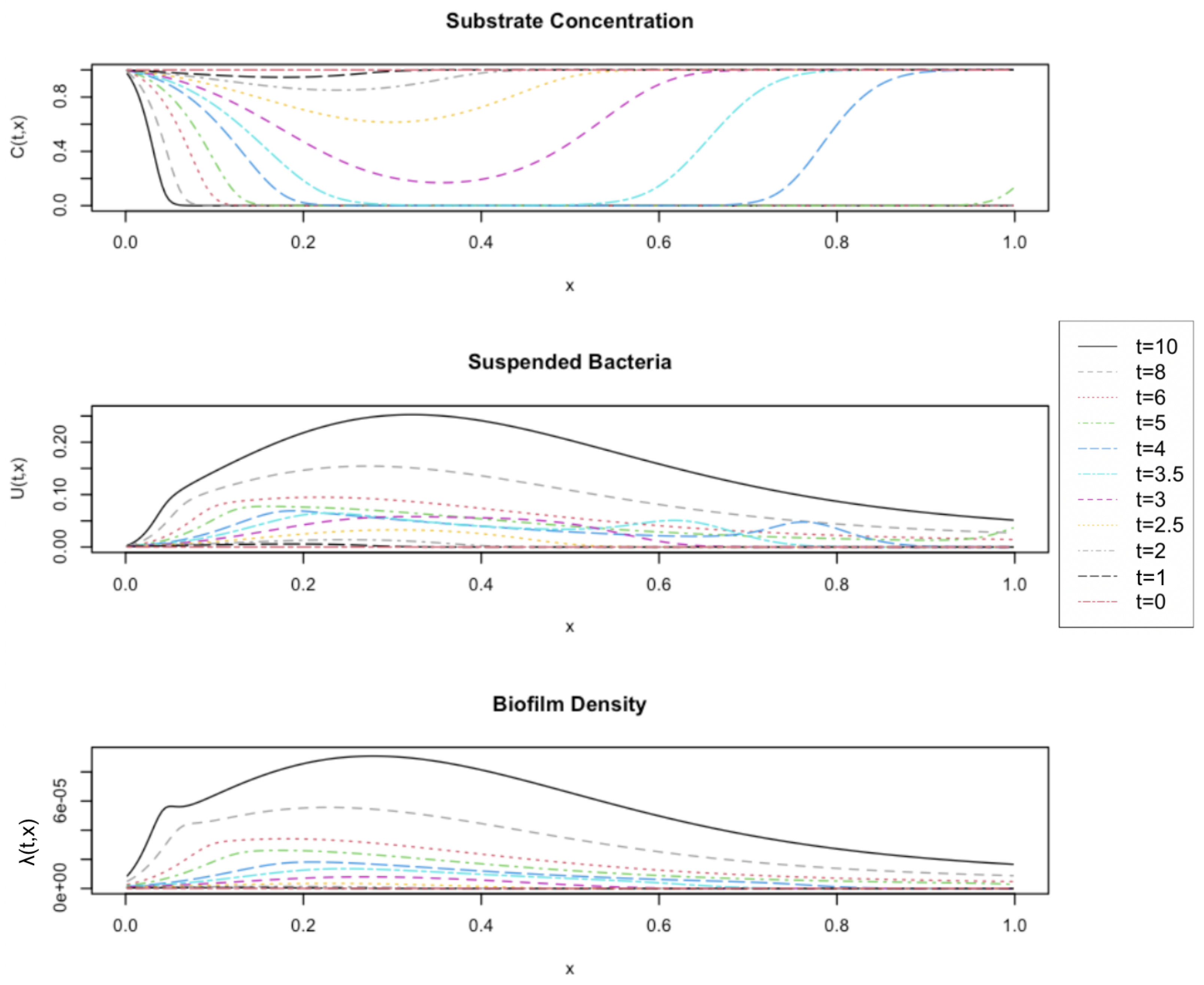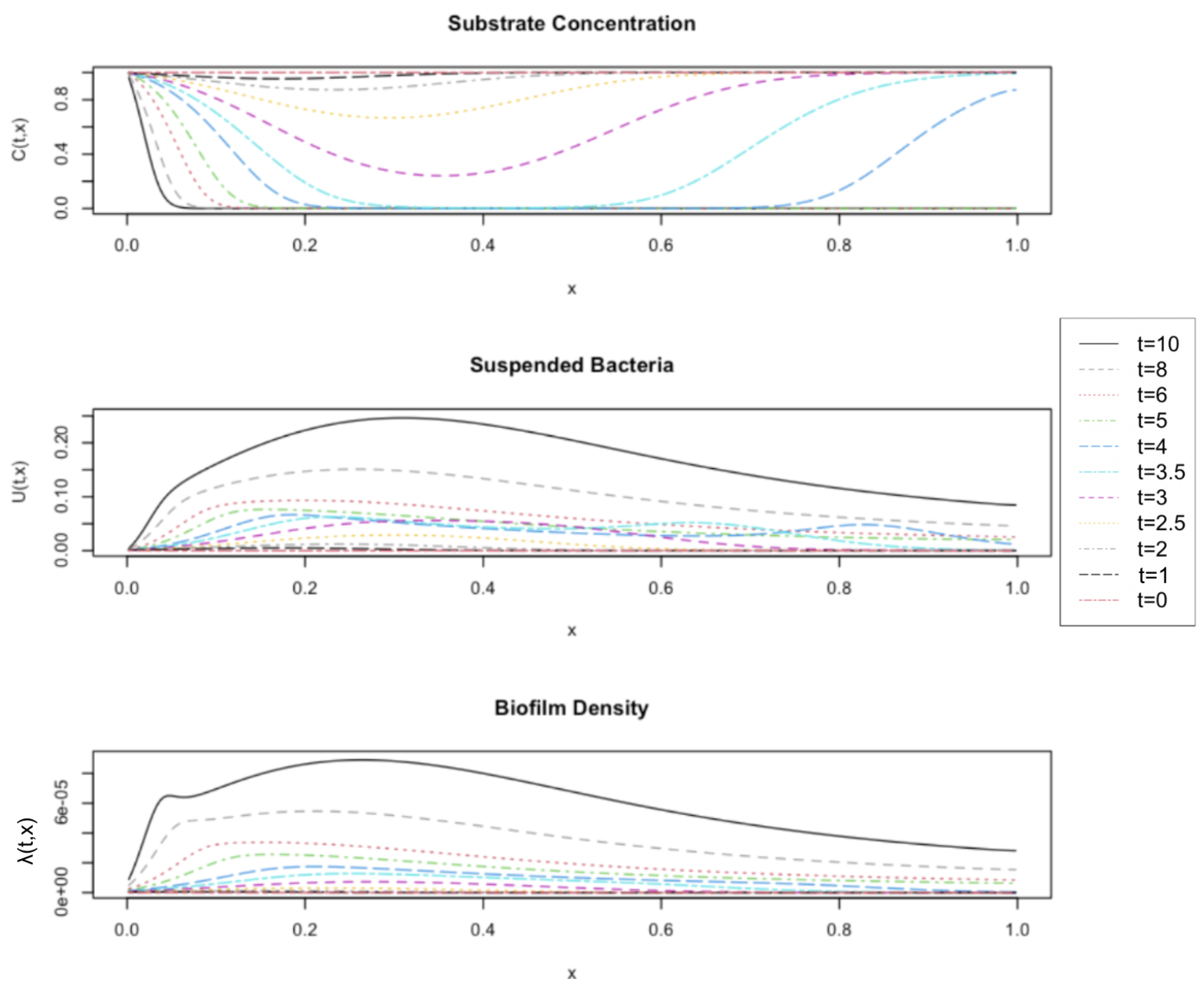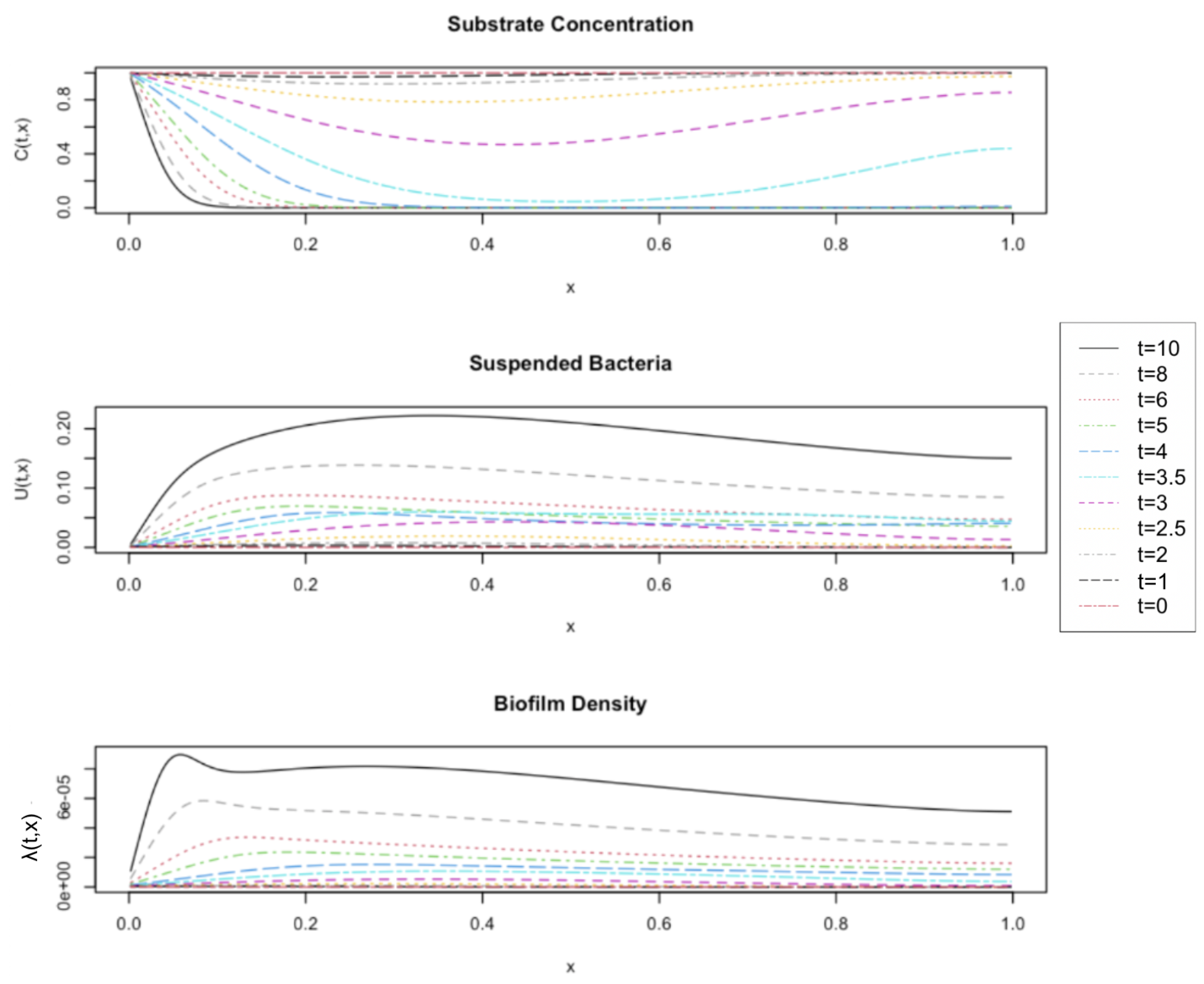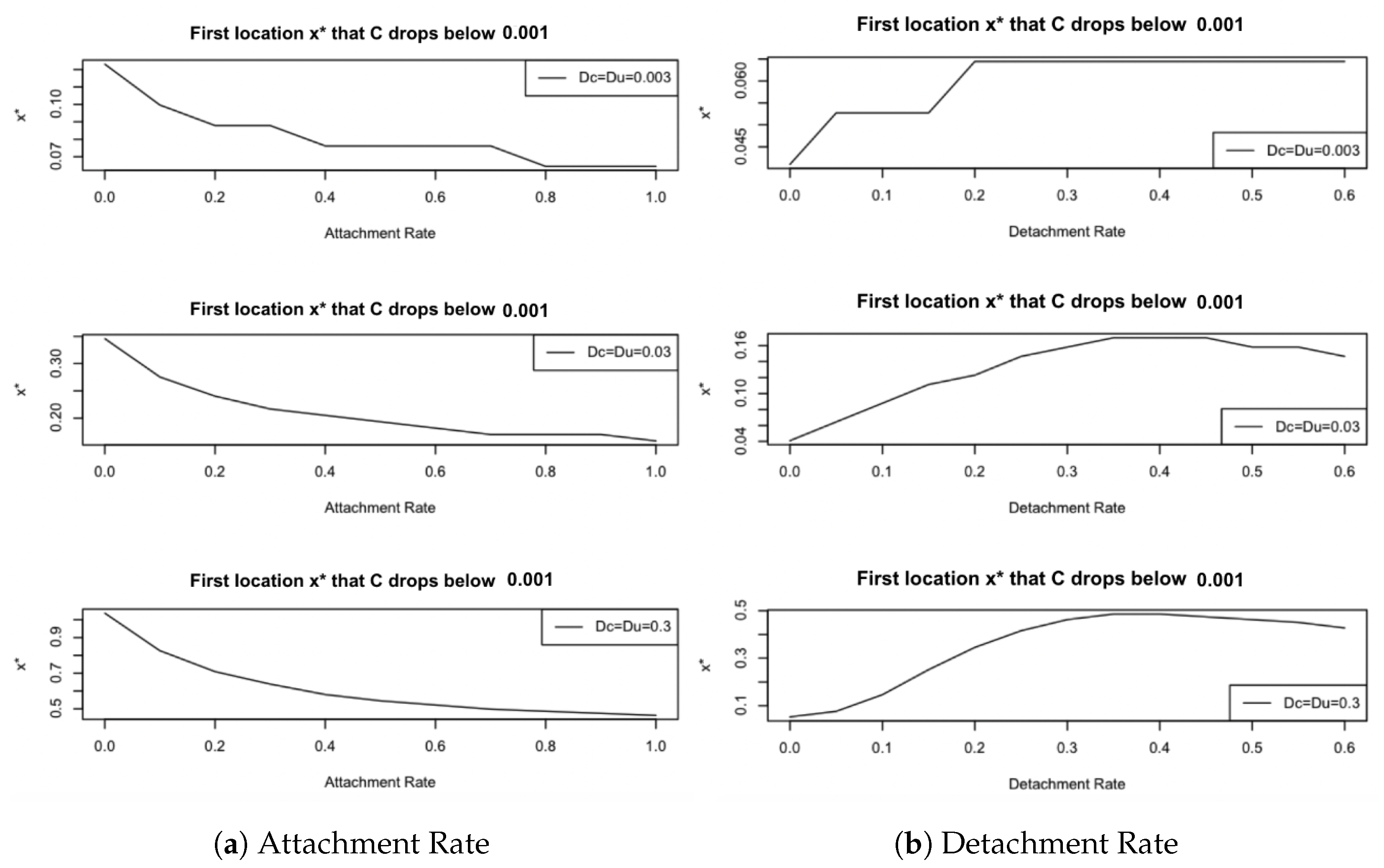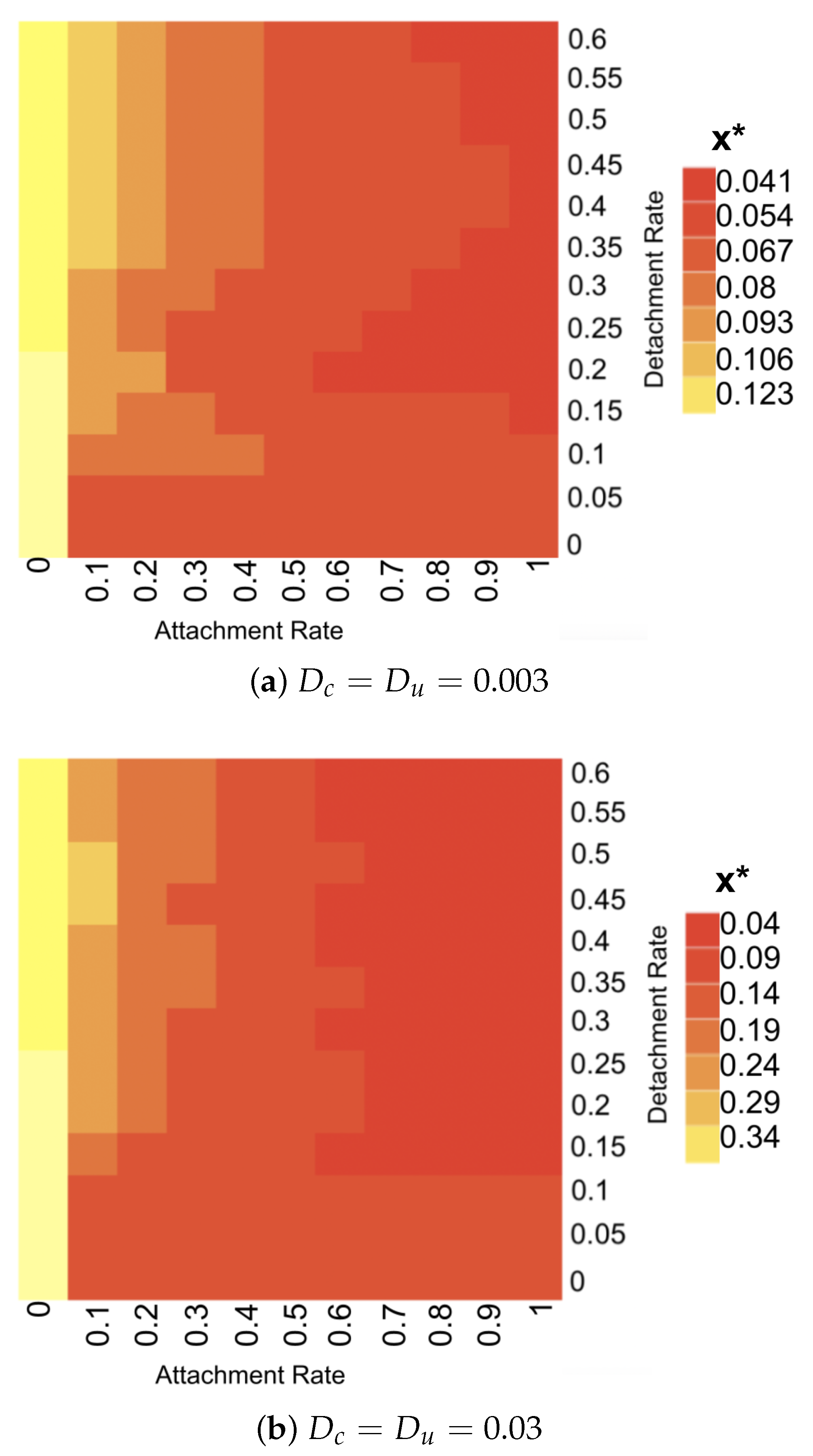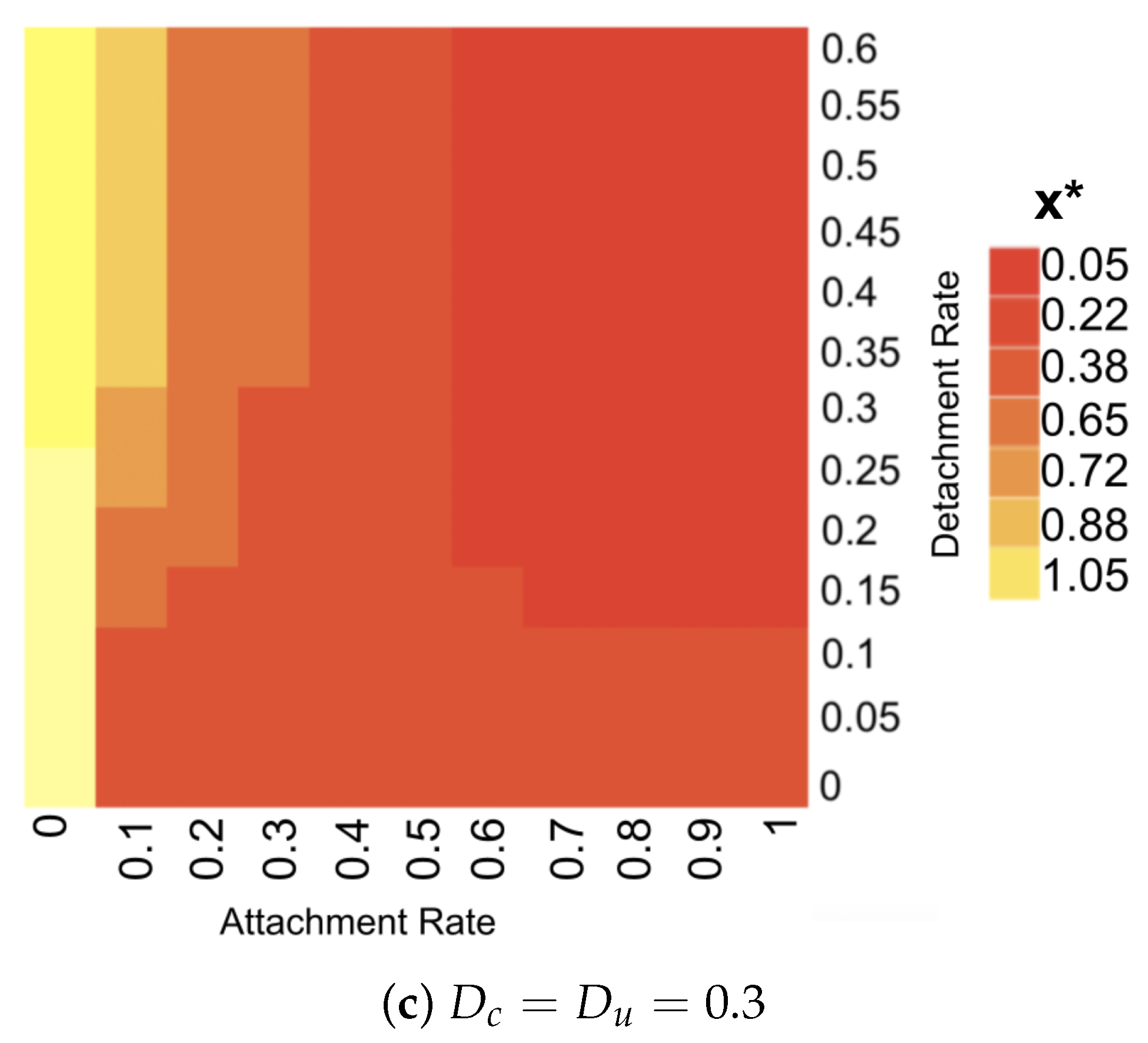1. Introduction
Bacterial biofilms are a collection of bacteria attached to an immersed surface (also known as substratum). After the initial attachment, they begin producing an extracellular polymeric substance (EPS) in which they are embedded. The EPS provides bacteria protection against mechanical washout and antimicrobials [
1].
In a medical context, biofilms are mostly detrimental, e.g., related to dental hygiene and bacterial infections. In environmental engineering they are used in wastewater treatment, soil remediation, and the protection of groundwater [
2,
3]. They play an important role in bioconversion processes in porous media. This prompts the development of mathematical and computational biofilm growth and accumulation models for such environments. In biofilm systems, growth-limiting nutrients are transported in the domain, which are utilized by bacteria for growth. As the biofilm forms, it interacts with and affects its environment. One such instance are reactive sub-surface bio-barriers: for example, aerobic biofilms have been used to degrade the oxygen in the environment in order to prevent subsequent oxygen dependent reactions that lead to the production and release of harmful contaminants, e.g., sulfuric acids that stem from an oxygen—iron sulfide reaction [
4]. In some applications of biofilms in porous media, bioclogging might become relevant, i.e., the phenomenon that pore space is filled by the biofilm, which affects flow conditions and might locally alter subsurface flow paths [
5].
Biofilms are naturally multi-scale structures, where the individual bacteria form the microscale (∼1 micron), biofilm colonies form the mesoscale (∼10–1000 microns), and the macroscale (>1 cm) is the scale of biofilm reactors and of natural or engineered systems. Similarly, timescales vary over several orders of magnitude, with biofilm growth on a timescale of days down to reactions in the biofilm in the order of minutes and mass transport and hydrodynamic effects in the order of seconds or less [
6].
Several modelling approaches have been used over the years to describe biofilm growth and several review articles have been published on the topic [
7,
8,
9]; we do not attempt a complete overview but restrict ourselves to making the direct connection from the early beginnings of biofilm modeling to the model that is the point of departure for the work that we present. In [
10], authors demonstrated that the steady-state biofilm kinetics model is essential in linking substrate flux to the thickness a biofilm can achieve under specific substrate concentrations. The model is a two-point boundary value problem for a 1D steady-state diffusion–reaction equation for the growth-limiting substrate with Monod uptake kinetics. This model still forms one of the foundations of 1D biofilm models, and, extended to an elliptic diffusion–reaction equation, also of many 2D- or 3D spatio-temporal mesoscopic biofilm formation models.
In 1986, Wanner and Gujer presented a 1D multispecies biofilm model [
11]. It established as a versatile platform to investigate microbial interactions in fixed biomass universally. The biofilm model contains nonlocal quasilinear hyperbolic balance equations for particulate system components coupled to an ordinary two-point moving boundary value problem for dissolved substrates. This model framework is nowadays routinely used in the engineering literature to study questions in biofilm-based environmental technology. It has been expanded by many authors to include additional biofilm processes. In [
11], the biofilm model is coupled with a mass balance for the biofilm reactor and an ad hoc model for detachment, i.e., the transfer of biomass from the biofilm into the aqueous phase. A recent open source implementation of this model framework is the Julia package
biofilm.jl [
12].
Alternative, mathematically simpler formulations for biofilm reactors with sessile bacteria are the Freter Model, Platte’s 0D biofilm model, and chemostat models with wall attachment, all of which are systems of ordinary differential equations. The Freter model for biofilm formation was originally presented in [
13]. In [
14], the authors explored the formation of a bacterial community in both Continuous Stirred Tank Reactor (CSTR) and Plug Flow Reactor (PFR) environments. The model assumes an extremely thin biofilm (essentially a monolayer in which substrate gradients can be neglected). The newly introduced attachment process is modeled as competition for space, i.e., there is an upper limit on the amount of biomass that can accumulate per unit attachment surface area. The CSTR and PFR outcomes are quite similar, allowing a general overview of the model’s behavior, independent of the bioreactor type. The model indicates two steady-state scenarios: washout or colonization, where colonization depends on bacterial growth balancing losses from flushing, sloughing, and cell death. The survival threshold for bacteria is typically set by flushing, as genetic control over sloughing is limited. Despite its simplicity, the Freter model serves as a useful reference for biofilm reactor studies, providing a starting point for other modeling approaches. Similar 0D biofilm descriptions (i.e., models without substrate diffusion in the bacterial layer) are assumed in Platte-style 0D biofilm models that do not explicitly resolve the spatial processes in the biofilm, cf. [
15,
16,
17], or in simple models of chemostats with wall attachment that can be found throughout the Mathematical Biology literature, e.g., [
18]. These models differ in the algebraic formulation of attachment and detachment terms and whether the model has a complexity that permits insightful analytical treatment or whether it is entirely designed as a simulation tool.
In [
19], authors compared Freter’s model for a single substrate and single species, with a model in which wall attached bacteria are described by a dynamically evolving 1D biofilm layer in which substrate diffusion is considered, as well as attachment and detachment. In essence, this is a single species version of the Wanner–Gujer model. This model is a hybrid model, in which an ordinary initial value problem for the reactor mass balance is coupled to a two-point moving boundary value problem for the substrate in the biofilm. Formally, this is still an ODE, the evaluation of the right hand side of which, however, requires the solution of a boundary value problem. Nevertheless, it permits with limitations the application of ODE methods. Despite the added biological, physical, and mathematical complexity, the model dynamics do not significantly change. Stability conditions for washout or persistence resemble, but are not identical to, those for Freter’s model, leading to a non-trivial equilibrium with both suspended and biofilm biomass. Biofilm growth is favored, especially at high flow rates where suspended biomass is prone to washout and substrate supply to the reactor is high. Increasing surface area boosts reactor performance up to a threshold. The research emphasizes the value of simplified models for initial qualitative insights, but calls also for more detailed computational studies. A multi-species reactor model for nitrification with Wanner–Gujer-like biofilm descriptions and attachment and detachment was presented by the same authors in [
20]. This study investigates the role of suspended biomass in a biofilm reactor, finding its higher contribution to nutrient removal at low dilution rates. Increased dilution rates and colonisable surface area influence steady-state values, affecting the nitrification process. The study recommends a detailed model if the focus is on specific microbial processes, but suggests a simpler biofilm-only model to study general reactor performance. Despite detachment’s impact on reactor performance, establishing simple correlations remains challenging due to model complexity.
The basis of our research comes from the findings and developments in [
21], where the authors simulated biofilm growth in porous media. This is an application and extension of the model in [
11]. It involves dividing the overall reactor into a relatively small finite number of compartments (namely 10; the authors noted that there is no visible change when split into 12 compartments), each of which is described by a Wanner–Gujer-like biofilm reactor with well-mixed bulk fluid but not considering suspended biomass and attachment. The outflow of one such compartment is the inflow into the subsequent downstream neighbor, similar to gradostat models. In [
22], Gaebler and Eberl took this spatially compartmentalized model of biofilm formation in porous media and extended the idea by transforming a discrete system of individual segments of size
into a continuous system by taking the continuous limit as
and thus deriving a PDE model in the macroscopic model.
Unlike the 0D Platte-type models, and unlike chemostat models with wall attachment, the models in [
21], as well as [
22] that is derived from it, consider diffusion into the biofilm, i.e., molecular diffusion perpendicular to the substratum. This is what we refer to here as
normal diffusion. In our study, we specifically investigate what we define to be
longitudinal diffusion in the main flow direction. Although the authors in [
21] discussed such longitudinal diffusion, the diffusion-like behavior they observed resulted from a coarse spatial discretization in the flow direction. This is the well-understood effect of artificial numerical diffusion, an error associated with finite difference approximations of advection terms that arose in their model naturally when describing transport out of one and into the next compartment. The authors explained that if the number of biofilm reactor compartments is increased, mass transport in the reactor becomes purely advective, i.e., the artificial diffusion effect vanishes. As a result, they asserted that their model lacks the capability to effectively simulate longitudinal diffusion in the bulk fluid.
In recent years, probably due to the availability of increasingly powerful desktop computing, it has become an increasingly common practice in biofilm reactor modeling to account for the exchange from biomass between the fixed film and the aquatic phase and to consider also suspended bacteria, both in models that are based on 1D Wanner–Gujer-like biofilm models [
19,
20,
23,
24] and also in [
12] (which, however, does not account for re-attachment), but also in simpler Platte-style 0D biofilm models that do not explicitly resolve the spatial processes in the biofilm, cf. [
15,
16,
17].
(Re-)Attachment of cells to the biofilm is commonly modeled as a first-order process, proportional to the concentration of bacteria in the aqueous phase. Detachment models for 1D biofilms have been in the literature since at least Wanner and Gujer’s seminal paper [
11]. Frequently, a second-order detachment formulation is used, although other descriptions have been proposed for just as long [
25,
26,
27,
28,
29]. Primarily, these are models of mechanical or passive detachment, caused by external forces. There are relatively few models of chemical or active detachment, say due to nutrient limitations or internally controlled by quorum sensing, as in [
24]. The second-order loss term for detachment essentially introduces a logistic nonlinearity and enforces an asymptotically stable steady state. Despite its widespread use over four decades, no convincing physical justification seems to be known, although authors of [
25] suggest that second-order detachment can be interpreted in the sense of Poiseuille like bulk flow induced shear forces, whereas first-order is more appropriate for Couette-like bulk flow. Only for very few and very specific experimental systems quantitative relationships between the detachment rate parameter and the reactor and reactor operating condition have been experimentally proposed, e.g., in [
30,
31]. For porous medium applications, it was shown previously in [
22] that their upscaling procedure from the biofilm to the reactor scale, which we also use, maintains first-order detachment, but that second-order mesoscale detachment does not have any effect in the macroscale description that is attained, but this has not been explored further.
In the present study, we extend the earlier advection–reaction model for substrate concentration and suspended and sessile bacteria in a porous medium to a diffusion–advection–reaction model. As a secondary objective of this study, we take a closer look at the role of attachment and detachment in the porous medium biofilm reactor model. This work builds on [
21,
22].
4. Discussion
The results in this paper express the importance of longitudinal diffusion in the model formation, even under circumstances where the diffusive contribution is very small compared to the advective one. While comparing a base model without diffusion to the new model with diffusion, we identified the changes in system dynamics as the Peclet number was decreased, hence the model becoming more diffusion dominated. This observation was further validated by examining the effect that diffusion had on the substrate depletion.
The role of attachment and detachment with diffusion was then studied, where, at least in the parameter range that we probed, attachment had more of an impact on substrate limitation than detachment. This becomes more pronounced as the diffusion coefficient is increased.
4.1. Multiscale Modeling of Biofilm Growth in Porous Media
Bacterial biofilms growing in porous media have an important ecological function in natural systems like soils as well as in engineered systems such as reactive biobarriers in ground water protection, in soil remediation processes, and in microbial sand filters, which find applications both in drinking water and in wastewater treatment [
38,
39].
In [
21], it was proposed to model biofilm accumulation in porous media by dividing the 1D domain into several compartments and to consider a series of 1D biofilm reactors, similar in approach to a gradostat model. This is also the point of departure for our model development. Like [
22], but unlike [
21], we included suspended bacteria in the pore space. Whereas in [
21], biofilm accumulation is simulated by using a relatively small finite number of such compartments, we follow [
22] and shrink such compartments each to a point, obtaining a nonlinear PDE-ODE coupled system on the macroscale. This system consists of quasilinear diffusion–advection–reaction equations for dissolved substrates and suspended biomass and an ODE in each point of the domain for the biofilm. The growth kinetics of the biofilm in the macroscale model that is obtained with this upscaling procedure is the same as the one used ad hoc and per assumption in Platte’s 0D biofilm reactor models, for example [
15,
16,
17], for environmental biotechnology applications in CSTRs. As such, our multiscaling approach also provides additional justification and support for that modeling framework.
In contrast to [
21,
22], we also consider in our model development longitudinal diffusion of substrate and suspended bacteria, i.e., diffusion in the main flow direction, in addition to the normal diffusion of substrate into the biofilm. In our simulation experiments that focus on de novo biofilm formation in clean beds, we observe that accounting for diffusion indeed has substantial effect: our results suggest that neglecting the contribution of diffusion tangential to the biofilm, in the main flow direction, may lead to underestimating quenching length, i.e., the distance over which the substrate is degraded, as well as biofilm accumulation downstream from the inlet. As expected, this is the more pronounced the smaller the reactor Peclet number is, i.e., the larger the contribution of diffusion to mass transport relative to the contribution of advection. Nevertheless, even in the strongly advection dominated case
, the effects of longitudinal diffusion are discernible.
A similar observation can be made about reactive biobarrier scenarios, in which, for example, bacteria are infused into the subsurface to deplete oxygen in an effort to prevent certain chemical reactions to happen that have environmental contaminants as a product [
4]. In systems in which several species interact and in which several dissolved substrates are transported and undergo reactions, as in the Uranium bio-reduction setting of [
32], it is difficult to predict in general whether neglecting diffusion overestimates or underestimates process efficiency, as this depends on the specifics of the system at hand. Our study shines some light on this question qualitatively.
4.2. Attachment and Detachment Modeling
Exchange of biomass between the biofilm phase and the aqueous phase is an important process in many natural or engineered biofilm systems. Since our main simulation focus is on clean bed simulation and hence de novo biofilm formation in porous media, including the attachment process is paramount, although it has mostly been neglected in modeling studies so far. Moreover, by neglecting suspended bacteria and how they attach, one neglects the contribution of unattached biomass to substrate degradation.
Attachment of bacteria from the aqueous phase to the substratum or to an already established biofilm is often neglected in biofilm modeling studies; for example, it is not considered by default in the probably most recent biofilm simulation software
biofilm.jl [
12], although a simple first-order attachment model was already proposed in [
40] and later reprised in [
19,
20]. The assumption there is that suspended bacteria attach directly to the biofilm surface or if no biofilm is present to the substratum. This model process is what we used in our mesoscale description and, under the upscaling procedure, also appears in the macroscopic model as a first-order term.
Alternatively, in a 2D model in [
41], suspended bacteria were assumed to be diffusing into and in the biofilm matrix. This idea was also implemented for Wanner–Gujer-style biofilm models in [
42] and several subsequent papers such as [
43]. We have not explored how this more involved mesoscopic model would behave in the upscaling process. This would require to perform in detail the limit process on the flux of biomass from the aqueous phase into the biofilm.
By contrast, including detachment is fairly routine in one-dimensional biofilm modeling. Usually, this considers passive detachment, i.e., detachment as a response of the biofilm to external factors. Only very few models of active detachment can be found, i.e., models in which detachment is the consequence of internal biofilm processes; for an example, see [
24], where for a single species, single substrate biofilm (the situation with which we are also concerned) models of quorum-sensing-induced detachment and of starvation-induced detachment are proposed and studied.
Passive detachment is commonly thought to be induced by external forces to the biofilm, mostly shear forces exerted by bulk flow [
44]. In many instances, bacterial biofilms form in heterogeneous structures, and the response of the biofilm to the fluid flow around it is a complicated fluid–structure interaction problem that depends on local shear forces which in turn depend strongly on local biofilm structure. In one-dimensional biofilm models in which the biofilm is described locally as a homogeneous slab, this can obviously only be described inadequately, and the possibility for a physics-based motivation and justification for such detachment model therefore is severely limited.
The most commonly used detachment formulation for 1D biofilm models, for which however, such a physics-based rationale appears to be lacking, is second-order detachment, where biomass loss is proportional to the square of the biofilm thickness. It was already shown in [
22,
32] that using this second-order model in the mesoscopic model leads to a substantial underestimation of detachment on the macroscale under our upscaling approach. As a model for passive detachment, the detachment coefficients should be relatable to the physical conditions in the biofilm reactor. Specifically, there is sufficient evidence for the role that the hydrodynamics in the aqueous phase plays in the detachment process, e.g., [
44] (but there are many more studies that could be cited here). Despite the widespread use of this second-order detachment model, this relationship between detachment coefficient and bulk hydrodynamics is a surprisingly little studied question, with [
30,
31] being noteworthy exceptions, both, however, focusing on particular reactor settings rather than a general theory.
In [
25], several mesoscopic detachment rate functions (as phenomenological constitutive relationships) for 1D biofilm models were studied from a long-term behavior analysis perspective, including some in which biomass loss is qualitatively (not quantitatively) related directly to reactor scale (i.e., global, not local) hydrodynamic conditions. In [
22], it was pointed out that under our upscaling procedure, these models, far from clogging—which is also the situation we encounter—behave either like the second-order model or like the first-order model that we use here. In particular, a shear-dependent detachment model that was developed based on empirical observations in [
35] several decades ago was found to behave like the first-order detachment model. A further argument for us to use this first-order detachment model is that it can be considered a linearization of any more involved nonlinear relationship about the washout equilibrium. In the case of the second-order detachment model, however, such a linearisation would yield a detachment coefficient
. This is the situation we also observe in our upscaling procedure for this model (cf. [
22,
32]). To better illustrate the difference between mesoscopic second-order and first-order detachment models, we consider first a situation in which the substrate does not become limited, such that
; then, the single species biofilm model with second-order detachment is well approximated by the logistic equation
where
is the maximum specific growth rate. Here, the second-order detachment function enforces an asymptotically stable equilibrium
. On the other hand, under such nutrient-rich conditions, the first-order detachment model leads to
which predicts unbounded growth for
and washout for
, in which case the biofilm does not attain a positive steady state. In this situation, obviously, a first-order detachment model is insufficient. In our setting, and in most realistic biofilm scenarios, the situation is different: substrate is not perpetually unlimited throughout the biofilm. As the biofilm grows, substrate becomes depleted. To illustrate this, for simplicity, we make the
ansatz that the biofilm growth rate
decreases as the biofilm grows. This situation is more adequately described by a differential equation,
Here is the biofilm-thickness-dependent detachment rate. At a nontrivial steady state , we have . Since g is monotonically decreasing and is monotonically non-decreasing (for example, it is constant for first-order detachment, increasing for second-order detachment), we find that . Hence, is an asymptotically stable equilibrium, even for first-order detachment, and the logistic nonlinearity is not required to bound biofilm growth.
These uncertainties about how to adequately include attachment and detachment processes in mesoscopic 1D biofilm models require an investigation into the sensitivity of model outcomes with respect to the parameters that describe biomass exchange between the aqueous and the biofilm phase. In our simulation experiments, it appears that the model shows less sensitivity to the detachment rates than to the attachment rates.
4.3. Potential Breakdown of the Model and Possibilities of Future Model Extensions
A potential breakdown situation of our modelling is that the important condition to keep open the flow channel is not necessarily guaranteed. If this happens, the pore space clogs, which in the physical system leads to flow being completely obstructed. This phenomenon can also occur in engineered systems, for example, in soil remediation, where whether or not such a breakdown happens depends, among other things, to a major extent on the soil properties and the bacterial growth conditions. For example, if the biofilm is able to clog the aqueous phase in bioventing, then this is not a suitable technology for the treatment of this soils, and similarly, our model would not be applicable. In analogy to these practical aspects, one might argue that our model framework is not suitable for situations where this occurs and needs to be appropriately extended. For example, depending on the mechanism that drives the flow (we assumed here constant flow rate), narrowing of the pore gap might lead to increased shear forces at the biofilm/water interface, i.e., requiring a solution-adaptive adjustment of the detachment rate; see also our discussion above. This poses the question of whether a detachment model that depends on these interfacial shear stresses might also prevent such model breakdown due to clogging. It might introduce a singularity in the detachment terms and as such considerably increase the complexity of the model. In this study, we remain firmly in the setting of the work from which we started, but it is important to pursue this question further.
Although our model is only formulated for a 1D setting, its extension to 2D or 3D scenarios seems relatively straightforward. Similarly, as demonstrated in [
32] for the model that considers only advective transport in the aqueous phase, an extension from the single substrate, single-species setting to multi-species systems is possible.
4.4. Choice of Upstream Bounday Conditions
In our simulation experiments, we fixed the upstream boundary condition to Dirichlet conditions which we think is a proper choice for some applications, e.g., in remediation settings like the ones we discussed above in
Section 2.4. In other applications, Danckwerts boundary conditions might be a better choice. These are of the type of Robin boundary conditions and reduce to Dirichlet boundary conditions for advection–reaction models, i.e., when the diffusion coefficient vanishes. That is, under such Danckwerts conditions, the advection–reaction model has the same solution as under Dirichlet conditions, but the advection–diffusion–reaction model does not. Specifically, both the inflow substrate concentration and the inflow concentration of suspended biomass differ from the values they attain in the advection–reaction model (i.e., the specified inflow concentration). This immediately leads to the conjecture that in systems with Danckwerts conditions, longitudinal diffusion should also not be neglected. The same rationale is applied to the generalized boundary condition proposed in [
45] for advection–diffusion–reaction equations, which are essentially a weighted average of Dirichlet and Danckwerts boundary conditions.
4.5. Limitations
The model that we derived and simulated here has many constant model parameters and coefficient functions that depend on the dependent variables
. Our simulation results and observations are only valid for the choices that we made here. We limited ourselves to investigate a select few key parameters, namely diffusion coefficients, detachment rate, and attachment rate. This choice was prompted by the fact that these are the three processes where our model differs most from the work that was our point of departure, namely [
21,
32]. This is not to say that relationships between other parameters or different choices of coefficient functions would be less interesting. For example, our assumption
throughout was somewhat arbitrary. It indeed would be very interesting to give up this restriction. We reserve this for future work, together with a major model extension that addresses the possible breakdown/clogging situation described above.
As discussed above, there is also much uncertainty about the detachment process in the biofilm literature (both modeling and experimental), which warrants a more specific investigation into this aspect.

